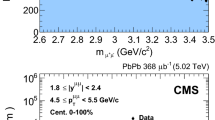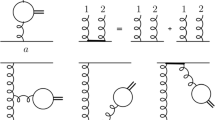Abstract.
Charm mesons produced in nucleus-nucleus collisions are expected to be less attenuated (quenched) by the medium than hadrons containing only light quarks, since radiative energy loss of heavy quarks should be reduced by the ‘dead-cone’ effect. We start from a published energy-loss model to derive the quenching for D mesons at the LHC, introducing an approximation of the dead-cone effect and employing a Glauber-based description of the geometry of central Pb-Pb collisions to estimate the in-medium path lengths of c quarks. We show that the exclusive reconstruction of \({\rm D}^0\to{\rm K\pi}^ + \) decays in ALICE allows to measure the nuclear modification factor of the D mesons transverse momentum distribution and the D/charged hadrons ratio and, thus, to investigate the energy loss of c quarks.
Similar content being viewed by others
References
ALICE Technical Proposal, CERN/LHCC 95-71 (1995)
M. Gyulassy, X.N. Wang, Nucl. Phys. B 420, 583 (1994) [arXiv:nucl-th/9306003]
R. Baier, Yu.L. Dokshitzer, A.H. Mueller, S. Peigné, D. Schiff, Nucl. Phys. B 483, 291 (1997) [arXiv:hep-ph/9607355]; Nucl. Phys. B 484, 265 (1997) [arXiv:hep-ph/9608322]
B.G. Zakharov, JETP Lett. 63, 952 (1996) [arXiv:hep-ph/9607440]
U.A. Wiedemann, Nucl. Phys. B 588, 303 (2000) [arXiv:hep-ph/0005129]
S.S. Adler et al., PHENIX Coll., Phys. Rev. Lett. 91, 072301 (2003) [arXiv:nucl-ex/0306021]
J. Jia et al., PHENIX Coll., Nucl. Phys. A 715, 769 (2003)c [arXiv:nucl-ex/0209029]
J. Adams et al., STAR Coll., Phys. Rev. Lett. 91, 172302 (2003). [arXiv:nucl-ex/0305015]
C. Adler et al., STAR Coll., Phys. Rev. Lett. 90, 082302 (2003) [arXiv:nucl-ex/0210033]
Yu.L. Dokshitzer, D.E. Kharzeev, Phys. Lett. B 519, 199 (2001) [arXiv:hep-ph/0106202]
C.A. Salgado, U.A. Wiedemann, Phys. Rev. D 68, 014008 (2003) [arXiv:hep-ph/0302184]; http://csalgado.home.cern.ch/csalgado
M. Gyulassy, P. Lévai, I. Vitev, Nucl. Phys. B 571, 197 (2000) [arXiv:hep-ph/9907461]; Phys. Rev. Lett. 85, 5535 (2000) [arXiv:nucl-th/0005032]; Nucl. Phys. B 594, 371 (2001) [arXiv:nucl-th/0006010]
A. Accardi et al., Hard Probes in Heavy Ion Collisions at the LHC: Jet Physics [arXiv:hep-ph/0310274]
M.G. Mustafa, D. Pal, D.K. Srivastava, M.H. Thoma, Phys. Lett. B 428, 234 (1998) [arXiv:nucl-th/9711095]
Z.W. Lin, R. Vogt, Nucl. Phys. B 544, 339 (1999) [arXiv:hep-ph/9808214]
Yu.L. Dokshitzer, V.A. Khoze, S.I. Troyan, J. Phys. G 17, 1602 (1991)
K. Adcox et al., PHENIX Coll., Phys. Rev. Lett. 88, 192303 (2002) [arXiv:nucl-ex/0202002]
M. Djordjevic, M. Gyulassy, Phys. Lett. B 560, 37 (2003) [arXiv:nucl-th/0302069]
E. Wang, X.N. Wang, B.W. Zhang [arXiv:nucl-th/0309040]
R. Baier, Yu.L. Dokshitzer, A.H. Mueller, D. Schiff, JHEP 0109, 033 (2001) [arXiv:hep-ph/0106347]
R.J. Glauber, G. Matthiae, Nucl. Phys. B 21, 135 (1970)
A. Drees, H. Feng, J. Jia [arXiv:nucl-th/0310044]
U.A. Wiedemann, Nucl. Phys. A 690, 731 (2001) [arXiv:hep-ph/0008241]
K.J. Eskola, H. Honkanen, C.A. Salgado, U.A. Wiedemann, work in progress
T. Sjöstrand et al., Computer Phys. Commun. 135, 238 (2001) [arXiv:hep-ph/0010017]
H.L. Lai et al., CTEQ Coll., Phys. Rev. D 55, 1280 (1997) [arXiv:hep-ph/9606399]
B.A. Kniehl, G. Kramer, B. Pötter, Nucl. Phys. B 582, 514 (2000) [arXiv:hep-ph/0010289]
C.A. Salgado, U.A. Wiedemann, private communication
M. Mangano, P. Nason, G. Ridolfi, Nucl. Phys. B 373, 295 (1992)
N. Carrer, A. Dainese, ALICE Internal Note, ALICE-INT-2003-019 (2003) [arXiv:hep-ph/0311225]
H.L. Lai et al., CTEQ Coll., Eur. Phys. J. C 12, 375 (2000) [arXiv:hep-ph/9903282]
K.J. Eskola, V.J. Kolhinen, C.A. Salgado, Eur. Phys. J. C 9, 61 (1999) [arXiv:hep-ph/9807297]
A. Dainese, Ph.D. Thesis [arXiv:nucl-ex/0311004]
N. Carrer, A. Dainese, R. Turrisi, J. Phys. G 29, 575 (2003)
Author information
Authors and Affiliations
Corresponding author
Additional information
Received: 4 December 2003, Published online: 3 March 2004
The publication of this paper has been authorized by the ALICE Collaboration
Rights and permissions
About this article
Cite this article
Dainese, A. Perspectives for the study of charm in-medium quenchingat the LHC with ALICE. Eur. Phys. J. C 33, 495–503 (2004). https://doi.org/10.1140/epjc/s2004-01645-4
Issue Date:
DOI: https://doi.org/10.1140/epjc/s2004-01645-4




